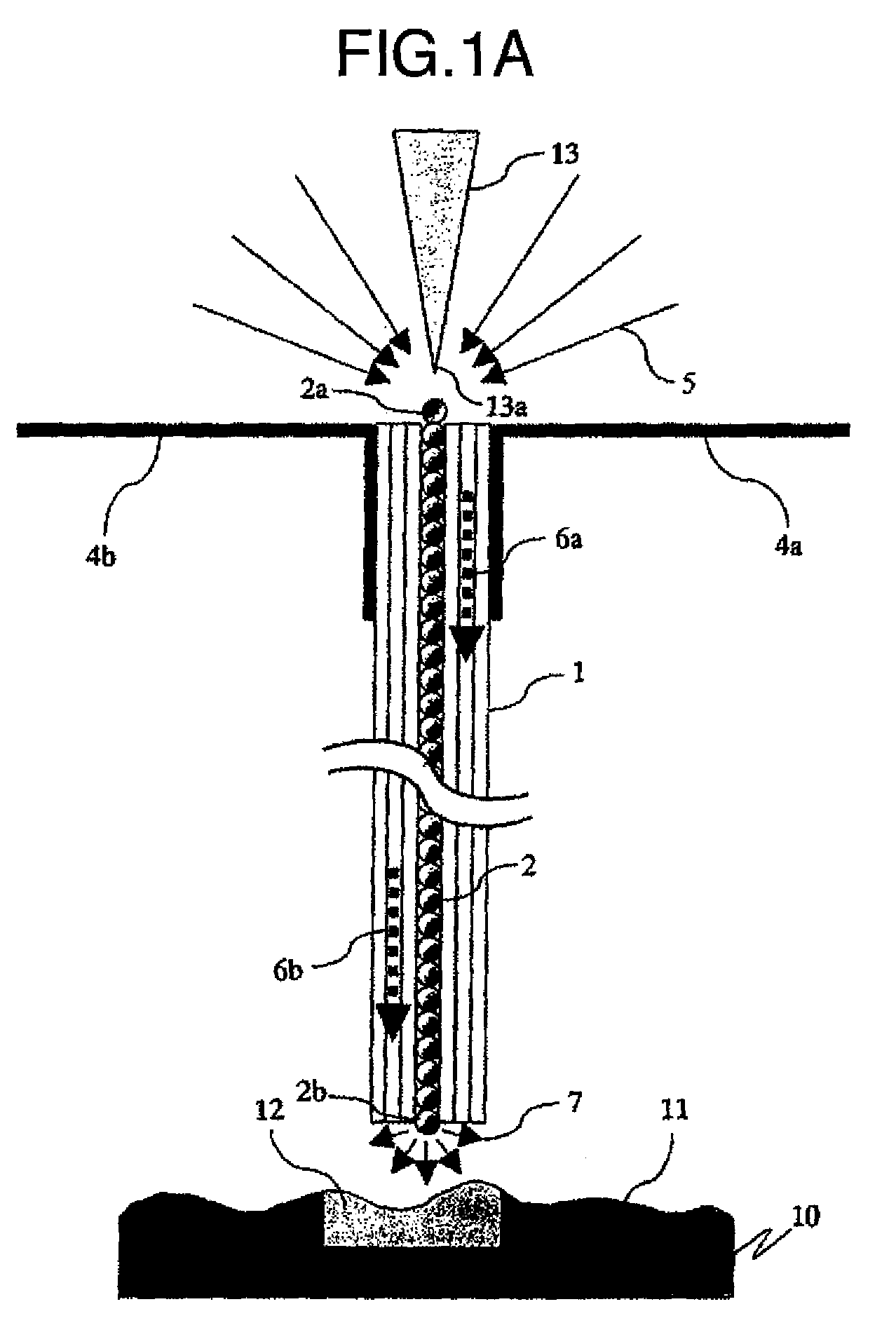Scanning probe microscope and sample observing method using the same
a scanning probe and microscope technology, applied in the direction of instruments, surface/boundary effects, measurement devices, etc., can solve the problems of atomic force microscopes not measuring optical properties, spatial resolution coming short in general raman spectroscopic micrometers, and limit in classifying performance, etc., to achieve high repeatability, improve defect classifying performance, and high yield ratio
- Summary
- Abstract
- Description
- Claims
- Application Information
AI Technical Summary
Benefits of technology
Problems solved by technology
Method used
Image
Examples
embodiment 1
[0026]A description will be given of a first embodiment in accordance with the present invention with reference to FIGS. 1, 2 and 8 to 11. In the present embodiment, as shown in FIG. 1, a plasmon enhanced near field probe is constructed by filling a spherical nano particle 2 of Au in an internal cavity portion of a multi-layer construction carbon nanotube (CNT) provided with a nature serving as a semiconductor or a boron nitride (BN) nanotube 1 exhibiting a nature serving as an insulating material. A filling method can make the inner portion of the nanotube 1 include the gold nano particle 2, for example, by putting the nanotube 1 in which both ends are opened by applying a high tension current or heating and the gold nano particle 2 within a vacuum chamber, carrying out a heating reaction and applying a capillary phenomenon. With regard to the application of the capillary phenomenon, for example, it is possible to apply such a technique as to be disclosed as (http: / / www1.accsnet.ne...
embodiment 2
[0071]A description will be given of a second embodiment in accordance with the present invention with reference to FIGS. 5A and 16. FIG. 5A shows a structure of a plasmon enhanced near field probe in accordance with the present embodiment. A material of the nanotube is a multilayer construction carbon nanotube 40 provided with a nature serving as a semiconductor, in the same manner as the first embodiment, or a boron nitride nanotube 40 exhibiting a nature serving as an insulating material. In the first embodiment and its modified embodiments, the nanotube in which both ends are opened is used, however, the present embodiment used the nanotube 40 in which both ends are closed, and a gold nano particle 2b is fixed to a lower end portion in accordance with a chemical modification or the like. If laser lights 50a and 50b having a wavelength 780 nm are irradiated in a state in which the nanotube 40 is moved down and the gold nano particle 2b is moved close to the sample 10, the gold na...
embodiment 3
[0083]A description will be given of a third embodiment in accordance with the present invention with reference to FIGS. 7 and 17. FIG. 7 shows a structure of a plasmon enhanced near field probe in the present embodiment. A material of the nano tube is a multilayer construction carbon nanotube 8 provided with a nature serving as the semiconductor in the same manner as the embodiment shown in FIG. 31B, or a boron nitride nanotube 8 exhibiting a nature serving as an insulating material. Further, its structure is absolutely the same as the structure shown in FIG. 31B.
[0084]FIG. 17 shows a structure of a scanning probe microscope mounting the present probe therein. Since the other structures and functions than the optical system are the same as the scanning probe microscope in the first embodiment shown in FIG. 8, a description thereof will be omitted. The light emitted from a semiconductor laser 300 having a wavelength 780 nm is divided into two sections by a beam splitter 302 having a...
PUM
| Property | Measurement | Unit |
|---|---|---|
| length | aaaaa | aaaaa |
| inner diameter | aaaaa | aaaaa |
| diameter | aaaaa | aaaaa |
Abstract
Description
Claims
Application Information
 Login to View More
Login to View More - R&D
- Intellectual Property
- Life Sciences
- Materials
- Tech Scout
- Unparalleled Data Quality
- Higher Quality Content
- 60% Fewer Hallucinations
Browse by: Latest US Patents, China's latest patents, Technical Efficacy Thesaurus, Application Domain, Technology Topic, Popular Technical Reports.
© 2025 PatSnap. All rights reserved.Legal|Privacy policy|Modern Slavery Act Transparency Statement|Sitemap|About US| Contact US: help@patsnap.com



